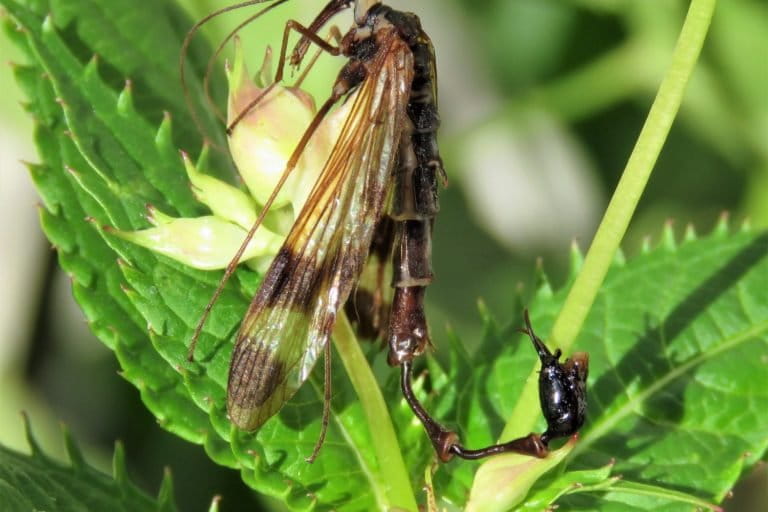- After closely examining long-held specimens of insects from Nepal, University of Göttingen zoologist Rainer Willmann has newly described and classified a previously unknown genus of scorpionfly he named Lulilan.
- These scorpionflies have an extremely long abdomen and tail and large genital structure that the male uses to grasp the female during copulation.
- Researchers say the presence of scorpionflies, which are threatened by development, insecticides and disease, indicate a healthy environment — and could be a positive sign for the diversity of Nepal’s insect life.
KATHMANDU– When German professor Jochen Martens and his associate W. Schawaller visited subtropical forests in Nepal in 1988, they collected samples of different insects found in eastern Nepal, including a “bizarre” one that had a long tail with a pincer resembling that of scorpions.
Martens, who paid several visits to Nepal along with his associates between 1969 and 1995, took the 1988 specimens to Germany where they remained preserved in alcohol at the University of Mainz without proper identification and classification.
However, when professor Rainer Willmann from the University of Göttingen recently looked at them closely, he was stunned.
Willmann, the author of a recent study published in the journal Contributions to Entomology, identified two of them as different species of “scorpionflies.”
“Scorpionflies are a group of insects such as dragonflies or butterflies, but the species of scorpionflies identified so far is less than 1,000 worldwide,” said Willmann, who came up with the genus name “Lulilan” for the species. He then named the two species Lulilan obscurus and Lulilan spinifer.
There was one more species of scorpionflies from Nepal described by Englishman Robert Hardwicke in 1823 that Willmann, one of a handful of specialists in the world studying scorpionflies, found to resemble the characteristics of other newly described members of the Lulilan genus. He named it Lulilan furcatus.

Willmann found L. obscurus to be particularly “spectacular.”
“It has an extremely long abdomen, the final body part, and this is a very long tail with a huge genital structure with which the male grasps the female during copulation,” he told Mongabay. As entomologists have never recorded scorpionflies with such an elongated tail, how they actually use it during copulation remains a mystery, said Willmann.
He added that scorpionflies are indicators of an undisturbed environment where the soil hasn’t been contaminated with chemicals or nutrients. “The larvae live in the soil and grow only when there is a silent and undisturbed environment. So they indicate a healthy environment,” he added.
According to the study, only scorpionflies so far described from Sumatra, Java and Bali have been found to resemble Lulilan. However, they are not closely related to Lulilan. “This is an amazing example where similar characteristics emerge independently, perhaps in response to similar evolutionary pressures,” said Willmann.
The professor said scorpionflies around the world face a wide range of threats, especially related to changes in land use. “In China, they are threatened because of the intense land use. In some areas, hilly landscapes with forestland were developed for use and the scorpionflies disappeared,” he added. “Then there are threats posed by insecticides and diseases that infect other insects, as scorpionflies rely on carcasses of other insects,” he said.
Nepali entomologist Sundar Tiwari, also the head of the department of entomology at the Agriculture and Forestry University, said the discovery highlights the insect diversity of Nepal, where only the diversity of megafauna such as Bengal tigers (Panthera tigris) and rhinos (Rhinoceros unicornis) get a lot of attention. “The discovery indicates that there may be many other insect species in the country waiting to be discovered.” He agreed with Willmann that scorpionflies and insects in general were threatened by land use and agricultural practices in Nepal.
Building of unplanned roads in hilly areas, development of infrastructure and clearing of forests and habitats have all been found to have affected biodiversity.
Both Willmann and Tiwari said they can’t say whether the species of the genus Willmann described are alive today, let alone their population status. That’s why it’s a new area of research for entomologists, said Tiwari.
Banner Image: The preserved Lulilan obscurus photographed by Prof Willmann at a garden in Germany.
Feedback: Use this form to send a message to the author of this post. If you want to post a public comment, you can do that at the bottom of the page.
Citations:
Willmann, R. (2022). Neue Skorpionsfliegen (Mecoptera, Panorpidae) AUS nepal. Contributions to Entomology, 72(2), 309-320. doi:10.3897/contrib.entomol.72.e97277
